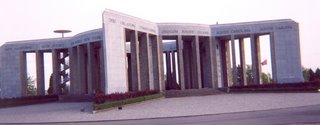Bastogne. World War II. Victory in Europe Day. VE Day. May 8 each year.
Mark that on your calendar if you are abroad at that time. It is an important date in Europe, where the experience of war is direct and devastating. Go even in the middle of the remembrance. For one or two, there is always a place to stay.
 American Soldiers' Memorial, Bastogne, Belgium
American Soldiers' Memorial, Bastogne, BelgiumBelgium is the area of the Battle of the Bulge. See //www.awon.org/bastogne/. At Bastogne, there were still veterans' groups there, several days after May 8. People come and stay, still.
The museum there has large exhibit and experiential areas, see the awon.org site for photos of it, and maps, and military strategy. Dan got lost in it - with the strobe lights, and sound booming, and exhibits opening onto exhibits with life-size figures and stage sets. That is part of the experience - where to go for safety. I was not far behind, but do watch out.
See also these sites for photos, and then an account of the military activity at Bastogne://www.army.mil/CMH/reference/bulge/images; and www.army.mil/cmh-pg/books/wwii/Bastogne/bast-fm. Go to the home page first, and only use the later address section to see you are at the place we reference.
These events are becoming remote - This was not my generation's war. Think of famous people you do know - General Patton, General McAuliffe with his response of "Nuts" when told to surrender by the German officer.
Textbooks can never lay out World War II to our children. Take them there. Anchor the history. Here is the memorial to the allies from their sacrifices in World War II.
There is continuing gratitude, even homage, to the Americans who fought here in WWII, and the principles they fought for in that era; and sadness and disbelief about the present.
,
 American Soldiers' Memorial, Bastogne, Belgium; view from the top
American Soldiers' Memorial, Bastogne, Belgium; view from the topThere is a fine view from the top of the memorial.
Precaution again: If you have small children at the museum, watch them closely, because it is realistic, strobe-lit, maze-like, and loud, to recreate some elements of battle itself. Easy to get involved and a child may wander. Dan was old enough to simply stay put until I came. A younger child may just keep going.
There is basically one way through, however, so if the adult keeps going, the child will probably reappear.
Only recently a war museum like these opened up in this country - the National World War I Museum in Kansas City, opened 12/2006. See www.libertymemorialmuseum.org/.
Don't miss the American memorial, a star shape, and go to the top, for the people they helped.
 Waterloo, Memorial to Wellington, the Victor over Napoleon
Waterloo, Memorial to Wellington, the Victor over Napoleon Castle, Luxembourg
Castle, Luxembourg General Patton, Grave, Hamm Military Cemetery, Luxembourg
General Patton, Grave, Hamm Military Cemetery, Luxembourg Tidy home, Luxembourg
Tidy home, Luxembourg Bruges, Belgium. Canals.
Bruges, Belgium. Canals. Bruges, Belgium. Town Hall
Bruges, Belgium. Town Hall Bruges, Belgium. Bridge, canal.
Bruges, Belgium. Bridge, canal.